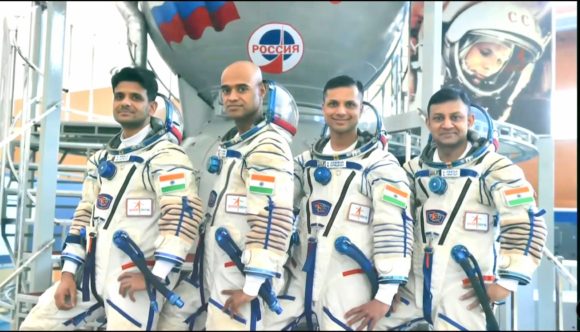On February 27, 2024, the Indian space agency ISRO announced the selection of the first astronauts for the Gajanyaan spacecraft. At a ceremony attended by Indian Prime Minister Narendra Modi, the names of four pilots from the Indian Air Force were announced: Prasanth Balakrishnan Nair, Ajit Krishnan, Angad Pratap, and Shubhanshu Shukla. The ceremony was held at Vikram Sarabhai Space Center (Kerala). One or two of them will form the main crew for the first flight with Gajanyan astronauts, scheduled for next year, and the rest will be part of the backup crew and subsequent missions. The Gaganyan capsule can carry up to three astronauts, but for the first flights it will have a crew of one or two people. We still don't know which pilots will fly Gaganyan's first mission, a decision that will be made officially in the coming months.

The four astronauts have trained extensively at Star City (TSPK) in Moscow (a group of Indian pilots are known to have visited TsPK for training, but their names have not been announced yet). Aside from general training, the TsPK visit is beneficial for ISRO because it appears that for Gaganyaan's first flights, the astronauts will be using Russian Sokol-KV2 IVA diving suits (ISRO is developing a Sokol version, but it looks like it won't). Be prepared for the first tasks). One of these four astronauts, who will likely be chosen as the commander of the first crewed flight, will participate in the SpaceX Crew Dragon Axiom 4 mission to the International Space Station later this year. This will allow Gajanyan's first manned mission to have at least one veteran astronaut. It is noteworthy that the first Indian astronaut was Rakesh Sharma, who flew to the Soviet space station Salyut 7 aboard the Soyuz T-11 spacecraft in April 1984. Since then, no Indian citizen has returned to space to represent his country (NASA astronauts are of Indian origin). Officially represents the United States).

The two selected astronauts will travel on the Gaganyaan H1 mission, but before that, three unmanned orbital flights of the Indian spacecraft will take place. The Gaganyaan G1 mission will launch in July this year carrying the humanoid robot Vyomnitra (a robot capable of causing the most terrifying nightmares due to its terrifying appearance). If all goes well, the Gaganyaan G2 mission will fly at the end of 2024. The third unmanned mission, Gaganyaan G3, will take place in 2025. Assuming these three flights develop as planned, the Gaganyaan H1 will fly with a pioneer One or two spacecraft in 2025, but it would not be surprising if it is postponed to 2026. If it finally flies with one astronaut, India will be emulating the first spacecraft missions. The Soyuz and Shenzhou spacecraft from Russia and China, respectively, made their debut carrying a single crew member. The LVM3 missile (formerly known as GSLV Mk. III) will be used for all missions. In October 2023, ISRO conducted the TV-D1 suborbital test of the Gaganyaan escape system and further tests of this system are expected before the first crewed mission.


In November last year, Narendra Modi announced that his country's goal is to have a permanent space station in 2035 and to put an astronaut on the moon in 2040. The first module of the Indian space station (Bharatiya Antariksha Station) will have a mass of 8 tons and will be launched. Launching in 2028 using LVM3. To achieve this, India will significantly increase spending on the space programme, although its schedule remains very active. The Gaganyaan program was started nearly fifteen years ago under the name ISRO OV (Orbiter Vehicle), but it would not be until 2018 when Narendra Modi decided to strongly support the project. That year the program was named Gajanyan (गगनयान, “skyship” in Hindi) and it was announced that the first manned flight would take place in 2022 (the 75th anniversary of Indian independence). Budget issues and the Covid pandemic caused the release date to be delayed several times. So far, it is estimated that the Indian Space Research Organization has spent a little over $1 billion on the Gajanyaan programme.


It is commendable that India decided to announce its crews in advance and did not fall into the ridiculous Chinese practice of informing the components of each mission two days before the flight. Now all that remains is to wish good luck to future Indian astronauts. We hope that within a year we will have a fourth country on Earth capable of reaching space on its own.



“Beeraholic. Friend of animals everywhere. Evil web scholar. Zombie maven.”
